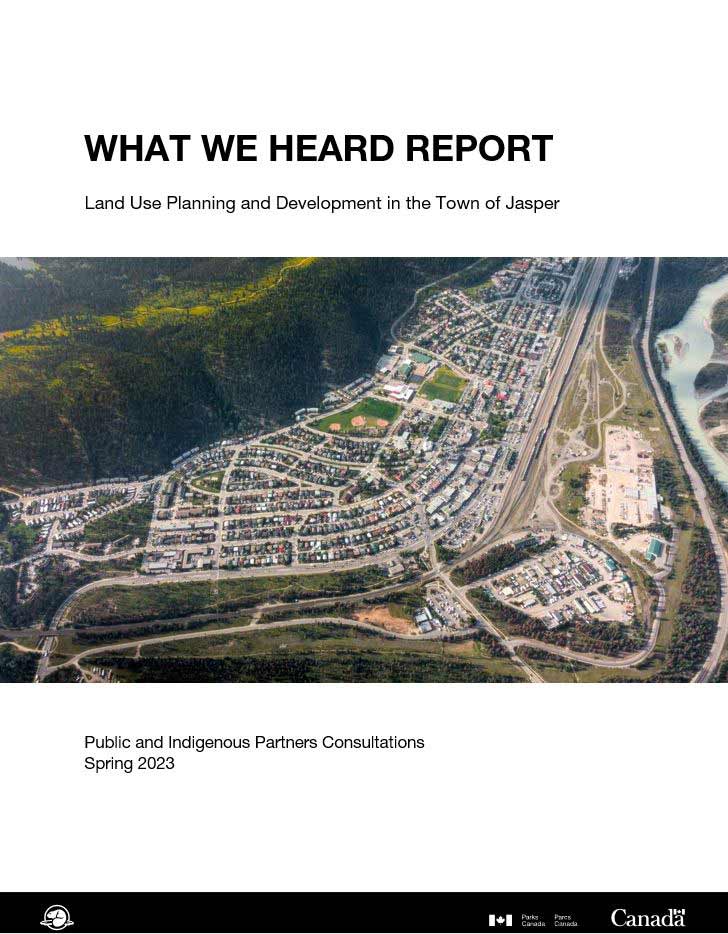
Table of contents
- Executive summary
- About the consultations
- How we engaged
- What we heard
- Conclusion
- Appendix – Survey
Executive summary
Parks Canada protects and presents approximately 450,000 square kilometres as the entrusted steward of these areas. As part of its mandate and commitment to stewardship of these places, Parks Canada is responsible for land use planning and development under the Canada National Parks Act.
Established in 1907, Jasper National Park is the largest and most northerly of the Canadian Rocky Mountain Parks UNESCO World Heritage Site. The park spans 11,228 square kilometres of broad valleys, rugged mountains, glaciers, vast forests, alpine meadows and wild rivers along the eastern slopes of the Rocky Mountains. The Municipality of Jasper has been an important partner providing services in the park community within Jasper National Park since incorporation in 2001 and operates in accordance with both the Canada National Parks Act and provincial legislation.
In 2022, the Municipality requested Parks Canada consider sharing responsibility for land use planning and development within the Town of Jasper boundaries. Importantly to note, both the Municipality and Parks Canada agreed that no changes are being considered to development limits in the Canada National Parks Act such as the maximum commercial floor area, commercial zoning, or the town boundaries.
Since the potential authorities being considered for examination in regards to land use planning and development could require legislative amendments, Parks Canada engaged with Canadians locally, regionally, and nationally. This ensured representation of a broad perspective of voices and opinions for a fair and transparent process on how the townsite within Jasper National Park should be managed and preserved into the future. This What We Heard Report was created following these public and Indigenous consultations held in early 2023.
The public consultation period was open from March 6, 2023, to April 19, 2023, and included an online engagement portal, in-person information sessions, news releases, stakeholder meetings and presentations at Jasper’s Annual Public Forum. Parks Canada encouraged participation through social media posts, Info Bulletins, print newspaper advertisements, direct emails, in-person at the Administration Building and Information Centre, and by conducting media interviews. In addition, the project team sought the perspectives of Indigenous partners whose traditional territory include Jasper National Park. Notification letters were sent in January and one-on-one meetings were held over the following months. We heard directly from approximately 150 participants in total.
This document summarizes all feedback received from all forms of virtual and in-person engagement. From these conversations four key themes emerged:
- Improving Land Use Planning Service Delivery
- Presenting a Simple Governance Model
- Updating the Community Vision
- Balancing Tourism-Based Development and Local Services
Following extensive outreach, there does not appear to be a strong desire to immediately begin the process to amend the Canada National Parks Act, regulations, and Establishment Agreement for Local Government in the Town of Jasper (2001). Instead, participants overwhelmingly felt that the underlying concerns should be addressed first before pursuing potentially lengthy governance changes.
Parks Canada will continue discussions with the Municipality of Jasper related to the sharing of responsibilities and will focus on land use planning and development policies and processes while considering the themes identified through these consultations.
Parks Canada looks forward to these conversations on the future of Jasper.
About the consultations
Parks Canada delivers land use planning and development services in accordance with the Canada National Parks Act. Section 9 of the Act was added following extensive parliamentary debate in 2000 when it was agreed that the incremental impacts of short-term land use planning decisions can have extensive long-term negative environmental impacts on such ecologically sensitive areas. Some of these responsibilities include plan development, zoning, permit approvals, subdivision of land approvals, variances, review and appeals, compliance and enforcement, and fees.
The Specialized Municipality of Jasper implements all aspects of municipal government in accordance with the Alberta Municipal Government Act, except those related to land use planning and development, annexation and the environment. In July 2022, the Municipality of Jasper requested that Parks Canada consider amending the Establishment Agreement for Local Government in the Town of Jasper (2001) to expand the services currently delivered by the Municipality within the town boundaries to include some responsibility for land use planning and development. Following discussions with the Municipality on their areas of interest, Parks Canada sought input from the public and Indigenous partners on the main issues of concern regarding land use planning and development in the Town of Jasper. The objectives of the public consultations were to:
- Facilitate a conversation on how land use planning and development services are delivered within the boundaries of the Town of Jasper and the cumulative impacts in a nationally protected area; and
- Seek feedback on the concept of sharing responsibilities for land use planning and development with the Municipality of Jasper.
In its written submission of April 19, 2023, the Municipality of Jasper outlined several concerns. It identified the need for more accountability to the community, more transparency, more clarity and consistency in land use policies and processes, improved long-range planning, and better responsiveness to local issues. Many of these issues were echoed by participants during the consultation process.
Parks Canada has responsibility to enhance the preservation, protection, and presentation of the park for current and future generation including townsites within National Parks. The consultations were to help to determine whether a new operating model should be developed with both the Municipality of Jasper and Parks Canada working together in land use planning.
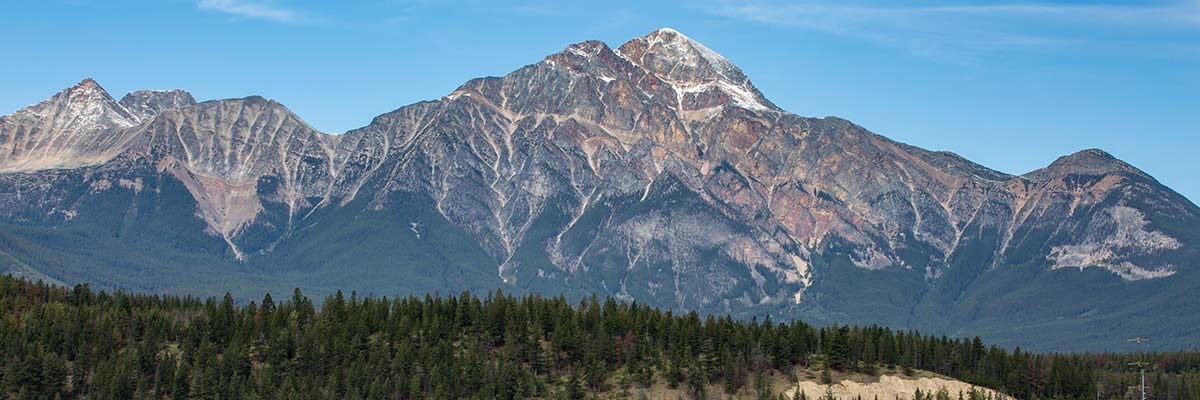
How we engaged
Timeline
This graphic shows the progression of the discussion from the formal request from the Municipality, public consultation, and final publication of the What We Heard Report.
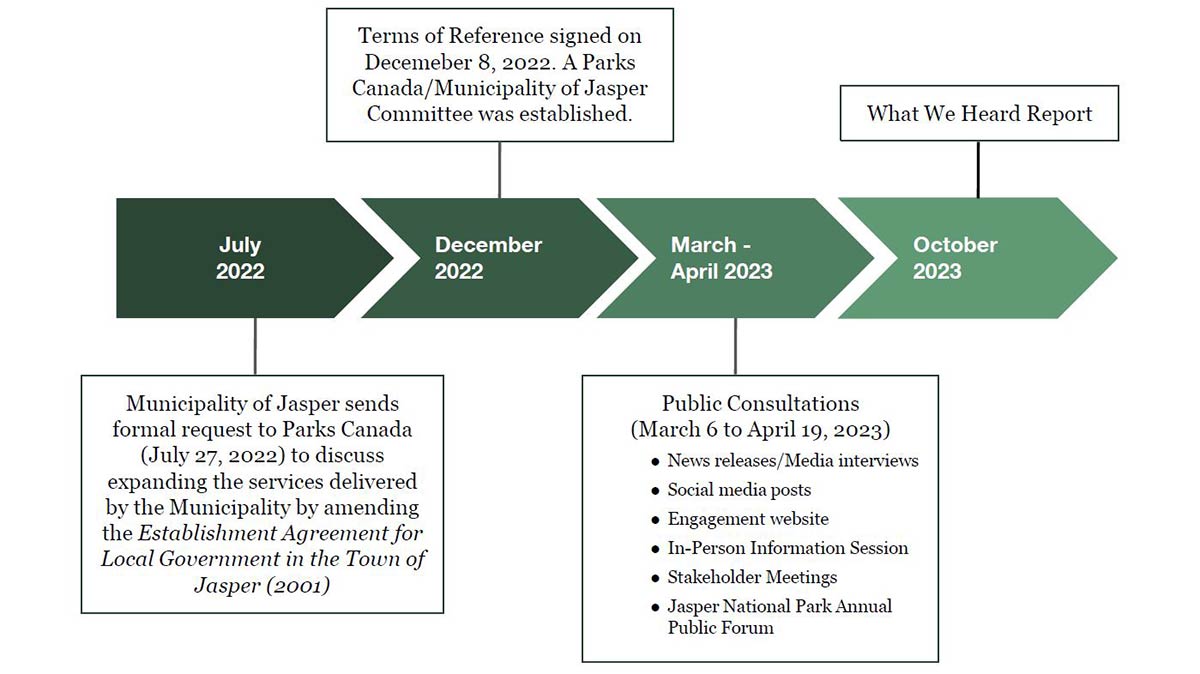
Text version
July 2022: Municipality of Jasper sends formal request to Parks Canada (July 27, 2022) to discuss expanding the services delivered by the Municipality by amending the Establishment Agreement for Local Government in the Town of Jasper (2001).
December 2022: Terms of Reference signed on December 8, 2022. A Parks Canada/Municipality of Jasper Committee was established.
March - April 2023: Public Consultations (March 6 to April 19, 2023)
- News releases/Media interviews
- Social media posts
- Engagement website
- In-Person Information Session
- Stakeholder Meetings
- Jasper National Park Annual Public Forum
October 2023: What We Heard Report
Online engagement
Screen capture from the engagement website.
At the start of the public consultation period on March 6, 2023, Parks Canada launched an online public engagement platform to seek feedback from all Canadians. Notifications were posted on the federal government “Consulting with Canadians” website to draw traffic. Located at the Parks Canada regional consultation hubs (www.LetsTalkMountainParks.ca and www.parlonsparcsdesmontagnes.ca), participants could learn more about the project and choose to provide feedback through a range of engagement tools such as answering a survey, posting to the Ideas Board and Map tool, or discussing topics directly with the project team. Available in both official languages, the two websites received over 1200 visitors during the consultation period.
Survey demographics
The survey (see Appendix) was open for all Canadians to complete online throughout the public consultation period from March 6 to April 19, 2023. It was comprised of 17 questions in total: 5 optional demographic questions, 10 on land use planning and development issues in the Town of Jasper, and 2 concluding questions. Many questions were designed as ‘open-ended’ to support the qualitative analysis of results. The survey was also available in paper form at the two Information Sessions and at the Jasper National Park Administration Office. A total of 109 completed responses were received.
Statistics from the optional demographic questions are presented below.

Text version
Where do you reside?
- Within the Town of Jasper: 66%
- Elsewhere in Alberta: 24%
- Elsewhere in Canada: 10%
As a resident of Jasper, how long have you lived here?
- Less than 2 years: 6%
- From 2 to 5 years: 11%
- From 5 to 10 years: 9%
- From 10 to 15 years: 17%
- More than 15 years: 57%
Social media statistics
Parks Canada posted about the consultations on social media multiple times during the consultation period to encourage participation online and at the in-person events. To engage national, regional and local audiences, the project team used both the national ‘Parks Canada’ and the local ‘Jasper National Park’ social media accounts on Facebook and Twitter. A news release was issued online, including direct mail to the Jasper National Park stakeholder list that includes 3,536 recipients from a broad range of locations. That email had an opening rate of 62 per cent.
Media coverage of the public consultation resulted in several stories that were published on Yahoo News, The Fitzhugh, National Park Traveler, National Post and affiliates, and a television media interview with CTV News -Alberta Primetime.
The statistics below include the reach and engagement from both English and French posts. Engagement on Facebook is classified as the number of likes, comments, shares and clicks. Engagement on Twitter is classified as the number of retweets, replies, follows and likes.
| Jasper National Park | Parks Canada | |
|---|---|---|
| Facebook Reach | 21,561 people | 22,940 people |
| Facebook Engagement | 348 | 133 |
| Twitter Reach | 21,296 people | 12,545 people |
| Twitter Engagement | 145 | 43 |
In-person information session

The in-person Information Sessions took place in Jasper on March 16, 2023, at the Forest Park Hotel. The event had two identical sessions: one beginning at 1:30 p.m. and the other at 6 p.m. To start off the sessions, opening remarks were delivered by Parks Canada and the Municipality of Jasper. Between both sessions, 36 people attended. The event was organized as a World Café engagement style where participants were split into small groups and could choose from a range of topics on land use planning and development to discuss with Parks Canada moderators. Participants were asked four questions per topic and could provide comments using sticky notes on poster boards. The sessions were recorded to aid in the development of this report.
The topics were as follows:
Topic A: Managing Commercial Development
This table topic focused on the enforcement of the Canada National Parks Act as it relates to different commercial activities such as limits to development (maximum commercial floor area and commercial zone), home-based businesses, and tourist-oriented services versus residential services.
Topic B: Protecting Ecological Integrity
Discussions focused on Parks Canada’s ongoing responsibilities under the Impact Assessment Act and how the Municipality of Jasper could assist in delivering land use planning services, while considering the significant impacts of tourism and other environmental concerns have on sustainability and the protection of the national park.
Topic C: Planning Approvals for Residential Projects
Attendees were able to discuss their experiences with the permit process as it relates to applying for residential project permits such as home renovations, new builds, demolitions, or related works.
Topic D: Community Planning and Town Character
Attendees were asked about the existing planning policy framework, how Parks Canada should protect the town’s built form, zoning, and ways to maintain or improve its character. The livability and walkability of the community was also discussed.
To ensure that participants understood the scope of work underway, an overview presentation was delivered by Parks Canada at the beginning of each session. In addition, there were two other table discussions from which participants could choose: Topic E: General Inquiries and Topic F: Land Use Planning 101. These tables provided a space for all questions to be asked and to get information from Parks Canada moderators regarding technical land use planning concepts and terms.
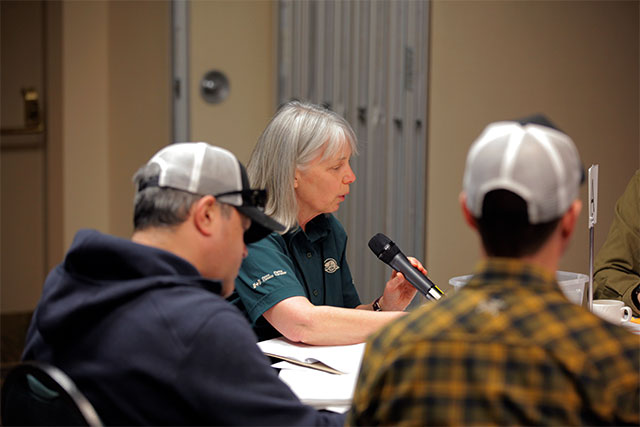
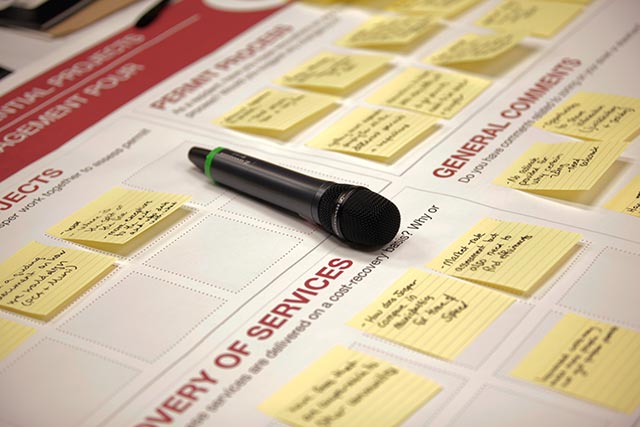
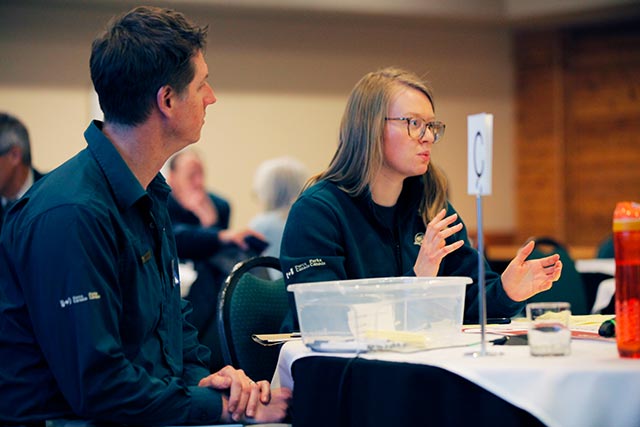
Stakeholder meetings
Targeted meetings
During the 45-day public consultation period, Parks Canada heard from multiple stakeholder groups who have an interest in how land use planning services are delivered in the Town of Jasper. These included environmental groups, local business organizations, professional planners, governance experts, tourism operators, and recreational organizations.
In total the project team held seven stakeholder meetings with these groups that represented national, regional, and local interests. The project team is grateful for the time taken by these individuals to provide their expertise and perspectives on what should be considered, including the historical context of the current operating model under the Establishment Agreement for Local Government and the prohibitions related to land use planning and development in the Canada National Parks Act.
Jasper National Park Annual Public Forum
The consultation period also coincided with one of the largest outreach activities held in Jasper National Park; the Annual Public Forum held on April 19, 2023. Due to the pandemic, it was the first in-person forum held since 2019. Virtual annual forums were held in the interim years.
Set up as a trade show style, participants at the Forum could speak with Jasper National Park staff on a variety of topics related to the park as a whole. A booth was also set up to address land use planning and development in the Town of Jasper. In total, approximately 50 people attended the annual forum. The project team spoke with many of these participants to get their feedback on how to move forward and to encourage them to fill out the survey online or by submitting them back to the Administration Office.
Indigenous consultation
Context
Long before Jasper was established as a national park, First Nations and Métis peoples lived and made their home on these lands. Some lived in the region year-round, while others came to the area on a seasonal basis for harvest, ceremony, travel or trade. The park was established in 1907. Shortly thereafter, Indigenous peoples were forcibly removed and excluded from park boundaries, as colonial government policies at the time considered Indigenous peoples to be incompatible with park establishment. Government practices and policies disconnected Indigenous peoples from their traditionally used lands and waters and caused significant negative impacts to their communities that persist to this day.
Consultation process
Modifications to the Canada National Parks Acton how land use planning and development services are delivered in the park community would be a significant governance change. As a result, the consultation process included all Indigenous communities and groups whose traditional territory include Jasper National Park.
Jasper National Park is located in Treaty 6 and 8 as well as the traditional lands of the Anishinabe, Aseniwuche Winewak, Dene-zaa, Nêhiyawak, Secwépemc, Stoney Nakoda, Mountain Métis and Métis.
Notification letters were sent out in January 2023 to 24 Indigenous partners. These letters explained the scope of work underway, the potential impacts, and invited feedback on what to consider in proposing a new model so that Indigenous interests and rights are protected.
Over the following months several follow-up communications were sent. The project team heard from six partners in total and met directly with four First Nations who brought forward a variety of perspectives and historical connections to Jasper.
From these conversations, we heard that:
- There is a desire to be more involved in the long-range planning processes in town such as the upcoming Community Plan and policy renewal, with less interest in the delivery of individual permits or project consultations;
- Over-development and commercialization are concerning and should be closely monitored by Parks Canada, including maintaining the limits to development;
- Designation of space for future Indigenous use is important for reconciliation and as a means of reconnecting with the land in the Park; and
- Improved relationships with the Municipality are vital.
Parks Canada is committed to building strong and mutually beneficial working relationships with Indigenous peoples, for example through the Jasper Indigenous Forum and the Upper Athabasca Valley Elders Council. We are grateful for the time and perspectives shared on land use planning and development in Jasper
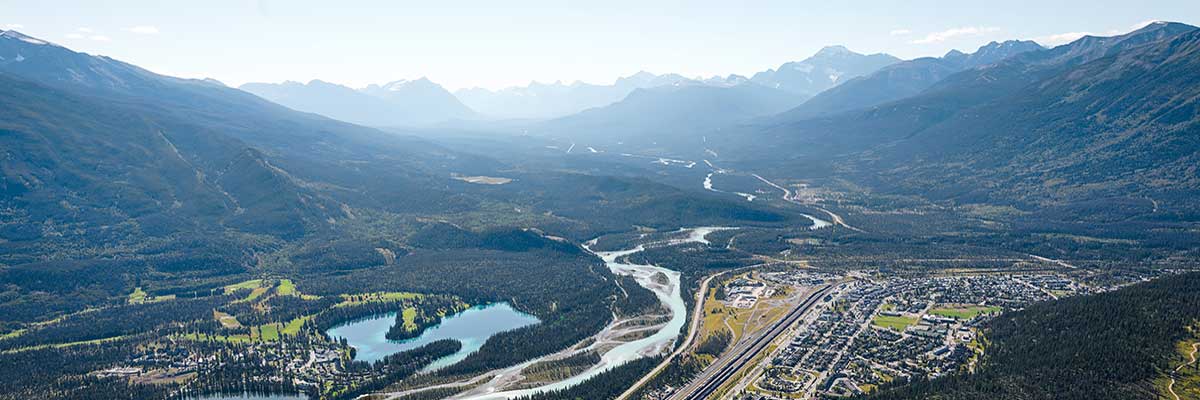
Photo: Tourism Jasper Tourism Jasper
What we heard
Key themes overview
Throughout the consultation process valuable and constructive comments and suggestions were received that has been summarized into the recurring themes below. The themes were created by consolidating all feedback received, including all virtual and in-person meetings, the survey, and online engagement.
- Improving Land Use Planning Service Delivery
The land use planning services currently delivered by Parks Canada need significant improvements as residents and business owners find the process complicated and inconsistent. - Presenting a Simple Governance Model
Having two government bodies involved in delivering these services may unnecessarily complicate the process. If this path were to be taken, each body should have clear roles and responsibilities that are properly communicated to residents and business owners. It is essential for both governments to first have a trusting and strong relationship with each other. - Updating the Community Vision
Jasper has a unique ‘Town in the Park’ character that stands out among other municipalities in Canada. Participants felt this sense of place should be protected and preserved and that the existing land use plans and policies affecting the park community need to be updated to reflect this. Alternative transportation and housing options should also be considered to improve the livability of the community. - Balancing Tourism-Based Development and Local Services
Participants shared that finding a balance between services that cater to tourists and residents is important. The influx of tourism should also be managed to ensure pollution and disturbance to wildlife is mitigated.
Quotes from engagement
Parks Canada heard a variety of perspectives and feedback from Canadians through the consultation process. The following are just a few participant quotes that have been pulled from the online survey and in-person information sessions.
"Offloading some of the responsibility from Parks to the Municipality has the potential to allow for more accountability and flexibility."
"I feel that Parks Canada has all of the services available in place already to continue the planning and development within the park."
"It’s important to preserve federal oversight when it comes to detailed impact assessments and protection of ecological integrity."
"The Architectural Motif is quite old. New residences are all very similar which takes away from the unique look that Jasper currently has."
"The system needs to be streamlined and simplified. Not multilayered and complicated."
"When Jasper voted for self government, it was very clearly stated that Parks Canada would never ever give up the very items you are now going to give away."
Key themes
1. Improving land use planning service delivery
Improved communication and collaboration
Parks Canada heard participants share their concerns regarding the inefficiency of communication between Parks Canada, the Municipality of Jasper, and the public. Information regarding proposed projects is not communicated effectively and some participants stated they are largely unaware until they are approved. Additionally, the communication mediums used by Parks Canada are not as effective as local news sources, which was recommended to be used more.
Communicating Clear Guidelines and Parameters
Participants raised concerns that there is a perception that Parks Canada may lack the knowledge and awareness regarding local land use planning issues. While these responsibilities in the park community are carried out by local staff in Jasper that work under the direction of the Park Superintendent, participants were dissatisfied with the current process for permit applications, stating that it is complicated, inconsistent, and time-consuming.
Costs
Participants are worried that the potential shift of responsibilities from Parks Canada (funded through federal tax dollars) to the Municipality of Jasper (funded through leaseholder tax dollars) may increase costs that will directly impact residents and business owners. Similarly, some participants expressed concern about being able to attract people to Jasper that have the right talent and experience in planning, leading some to conclude that lack of familiarity with the area has led to some issues in the past.
2. Presenting a simple governance model
Streamlined process
While some participants are open to having two governing bodies, most have expressed concern that it may overcomplicate processes and add more layers of approvals, especially given the continuing responsibility of Parks Canada under the Impact Assessment Act. If Parks Canada and the Municipality of Jasper were to share jurisdiction, each must have distinct roles and responsibilities that should be well-communicated to residents and business owners.
Some roles suggested for Parks Canada include assessing applications for large projects and commercial projects. Simultaneously, it was suggested the Municipality of Jasper could provide direct service delivery to leaseholders by issuing permits for smaller residential projects that do not require detailed environmental mitigation measures.
Ecological integrity and environmental protection
Protecting and preserving the environment was of significant concern to participants, including Parks Canada’s role to enforce mitigating measures as conditions of permits as required under the Impact Assessment Act. There was significant apprehension that ecological integrity may be negatively impacted if changes were pursued due to the unique nature of the town in the national park.
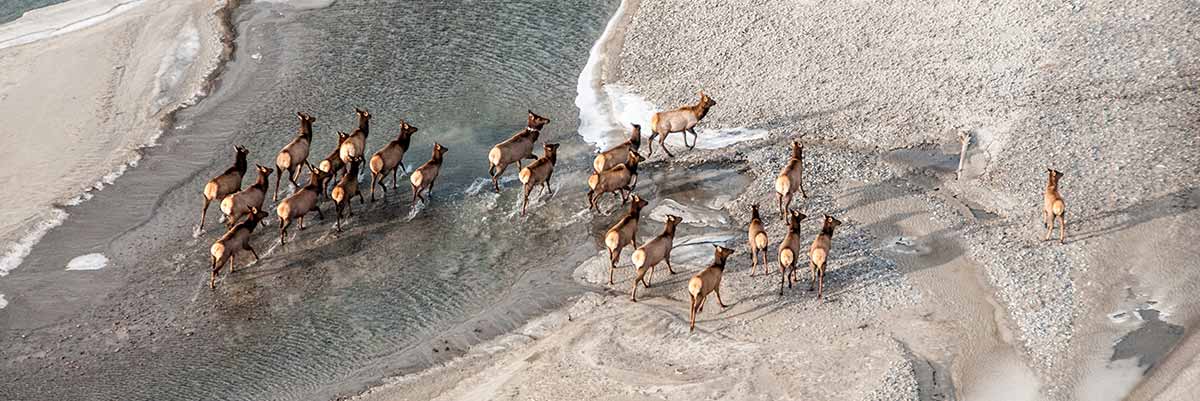
3. Updating the community vision
Clear policies and plans on the built form
Some who had experience with permits (e.g., home renovations) stated that the regulations and policies are contradictory and not easy to follow. Participants expressed interest in keeping standardized rules and regulations that should be strictly adhered to and consistently updated. Parks Canada is encouraged to create a streamlined Design Standards Handbook that is easily accessible to everyone.
A majority of participants encouraged Parks Canada to continue overseeing the implementation of architectural guidelines (e.g., Architectural Motif) to maintain the unique physical characteristics of Jasper. In addition, it was recognized that while the current Community Sustainability Plan was at one time effective, it is now outdated, and it is time to reset the vision to guide Jasper’s development for the next 30 years.
Transportation options
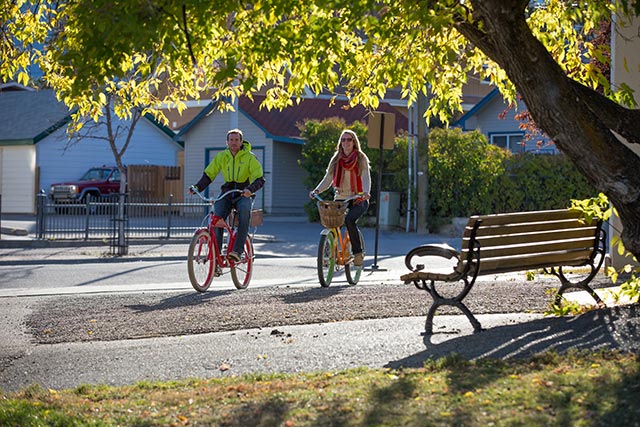
Participants articulated their concerns regarding the influx of vehicles in the Town of Jasper, making parking limited and inaccessible. Parks Canada should consider alternative transportation options (e.g., public buses) and implement more mobility infrastructure such as expanded walking and biking paths, bike lanes and bike racks.
Increased density
Several participants noted a housing crisis in the Town of Jasper and an increasing cost of living, hence a need for more affordable housing solutions. One recommendation is to incorporate residential units on top of commercial spaces. While Parks Canada currently encourages this type of mixed-use space, especially when considering how staff accommodations are integrated into new projects, this suggestion was noted as a future item to be integrated into the new Community Plan and supporting planning policies as they are developed in the coming years.
Best practices and lessons learned from Banff
A common theme heard throughout the engagement is that participants value and want to preserve the characteristics of the Town of Jasper with its quaint and unique appearance. As such, many participants mentioned that they were against Jasper being as commercialized as Banff. Although it was recognized that the Town of Banff was incorporated in 1989, before the current Canada National Parks Act prohibitions on land use planning and development came into force, some participants felt that there are lessons and best practices there that could be applied in Jasper.
4. Balancing tourism-based development and local services
Assess commercial needs
There were contrasting opinions regarding whether there is a need to re-evaluate the commercial cap set out in the Canada National Parks Act. Participants recognized the special responsibilities of living in an internationally recognized area and the need to limit negative ecological impacts of commercial development. However, there is a need to balance tourism-based developments and small businesses serving the local resident needs (e.g., daycare, home construction services such as plumbing and electricians). Considering all “commercial development” as the same can make it untenable to live in the national park.
Home-based businesses
Parks Canada heard that participants are struggling to run their businesses due to the limitations of the commercial cap and lack of permissible activities on home-based businesses. It was recommended that the definition for a home-based business be expanded beyond the two categories currently available.
Tourism management
Participants expressed concerns about the drawback of tourism, especially during the summer months, as it has negatively impacted the natural environment with excess pollution, heavy traffic, and disturbance to wildlife. Parks Canada is encouraged to observe stricter enforcement to protect the park and its ecological integrity.
Parking
There was a prevalent concern regarding the parking in the Town of Jasper. Some concerns include underground parking utilized by owners for other uses (e.g., storage space), accessibility and availability of parking during summer, and lack of parking in residential areas due to commercial uses.
Conclusion

This What We Heard Report is a summary of the comments and perspectives shared during the various consultation opportunities with Canadians across Canada, Indigenous partners and the residents and business owners in the Town of Jasper. The four interconnected themes illustrate the passion and connection participants have with their community and its role in the national park. Some comments also resonate from previous consultations on land use planning issues such as the permit process, zoning, and housing.
Parks Canada looks forward to continuing the conversation with the Municipality of Jasper and commits to pursuing actions required to improve service delivery in the areas outlined in the consultation.
For more information, contact:
- Daniel Mercer, urbaniste, RPP, MCIP
Manager, Land Use Planning Services
Daniel.Mercer@pc.gc.ca - Jasper National Park Media Relations
pnjmedia-jnpmedia@pc.gc.ca
-
Appendix - Survey
The following questions were asked as part of a voluntary survey during the Canada-wide consultation period. A quantitative analysis was not prepared given the low response rate. The results of the 109 completed responses were combined with the feedback received through all other engagement tools to develop the themes presented in this What We Heard Report.
Survey
We want to hear from you! Parks Canada is seeking feedback on land use planning services in the Town of Jasper. The following survey provides an opportunity for you to reflect and share your insight to how Parks Canada and the Municipality of Jasper can improve delivery of services in this community. To gain a better understanding of this initiative, please review the FAQs and background information on the website.
Parks Canada wants to ensure that this process reflects the values and views of Canadians and makes a meaningful contribution to the overall experience of residents and visitors in the Town of Jasper. Advice and feedback from Canadians is essential to achieving this. In this first stage of engagement, your feedback will help us create a What We Heard Report and recommendations to the Minister.
This survey will take about 10 minutes to complete.
Thank you for your participation!
All fields marked with an asterisk (*) are required.
Demographic Questions
Responses to the following demographic questions are optional. Your responses will help the project team understand who might be affected by future decisions on how land use planning is carried out in Jasper, and to ensure that we continue to engage in an inclusive manner.
- Where do you reside?
- Within the Town of Jasper
- Within Jasper National Park, but outside the Town of Jasper
- Elsewhere in Alberta
- Elsewhere in Canada
- Outside of Canada
- In an Indigenous community (e.g.: Reserve, Settlement)
- As a current full-time resident of the Town of Jasper, how long have you lived here?
- Less than 2 years
- From 2 to 5 years
- From 5 to 10 years
- From 10 to 15 years
- More than 15 years
- What is your age?
- Under 18
- 18-24
- 25-34
- 35-44
- 45-54
- 55-64
- 65+
- Which of the following best describes you? (Select all that apply)
- I am an interested member of the general public
- I am member of an Indigenous community whose traditional territory includes Jasper National Park
- I vacation/visit regularly in the Town of Jasper
- I work in the Town of Jasper
- I am a member of tourism/hospitality industry
- I am a member of a non-governmental organization (NGO)
- I own a home in the Town of Jasper
- I rent a home/apartment/room/etc. in the Town of Jasper
- I own a cottage at Lake Edith
- I own a business, or am a developer/investor, in the Town of Jasper
- I own a commercial building in the Town of Jasper
- I rent a commercial space in the Town of Jasper
- Other (please specify)
- As a business owner or developer/investor in the Town of Jasper, how long have you operated here?
- Less than 2 years
- From 2 to 5 years
- From 5 to 10 years
- From 10 to 15 years
- More than 15 years
- How strongly do you feel the Municipality of Jasper should have some responsibility in delivering land use planning and development services?*
- Definitely Agree
- Somewhat Agree
- Neither Agree nor Disagree
- Somewhat Disagree
- Definitely Disagree
- Please explain why you gave the ranking you did in the previous question.
Please add your comment here... - Are there some services that you believe Parks Canada should continue to deliver?*
- Reviews and appeals
- Building Permits
- Compliance and enforcement
- Development Permits for small projects
- Architectural Motif
- Development Permits for commercial projects
- Responsibility for ensuring code Inspections
- Variances
- Community plans
- Development permits for large projects
- Neighbourhood plans and other land use plans
- Development Permits for residential projects
- Other (please specify)
- Are there some services that you believe the Municipality of Jasper should deliver?*
- Reviews and appeals
- Building Permits
- Compliance and enforcement
- Development Permits for small projects
- Architectural Motif
- Development Permits for commercial projects
- Responsibility for ensuring code Inspections
- Variances
- Community plans
- Development permits for large projects
- Neighbourhood plans and other land use plans
- Development Permits for residential projects
- Other (please specify)
- How important to you is administering planning services on a cost-recovery basis?*
- Very Important
- Somewhat Important
- Neutral
- Somewhat Unimportant
- Very Unimportant
- In addition to the oversight role as the regulator, how would you describe the role that Parks Canada should play in land use planning and development in the Town of Jasper?*
Please add your comment here... - Considering your answer above, how would you rank the following as priorities for Parks Canada in land use planning and development in the Town of Jasper?*
- Manage the density and intensity of new development by regulating the size and layout of lots and buildings
- Improve flexibility of development standards
- Reduce land use conflicts by managing the location of single-family, multi-family, and commercial development
- Encourage economic development in the community; within the limits set in the Canada National Parks Act
- Encourage improved performance in landscaping, storm water management, or eco-friendly building features
- Ensure ecological integrity of the National Park is maintained or restored
- Retain and enhance community appearance through landscaping, sign, lighting, and architectural standard
- What in the Town of Jasper should be addressed to help protect or improve the town's overall character?
Please add your comment here... - What are some potential opportunities or benefits of having the Municipality of Jasper deliver some land use planning and development services?
Please add your comment here... - What do you believe some of the issues or challenges might be if the Municipality of Jasper delivers some land use planning and development services?
Please add your comment here... - Do you have any other comments land use planning and development in the Town of Jasper?
Please add your comment here... - Where did you hear about these consultations?
- Search Engine (e.g. Google, Bing, Baidu)
- Parks Canada News Release
- Jasper National Park Bulletin
- Consulting with Canadians
- Fitzhugh Advertisement
- Social Media (e.g.: Facebook, LinkedIn, Twitter)
- Parks Canada direct email
- Other (please specify)
General Perception
Currently, all land use planning and development services in Jasper National Park are delivered by Parks Canada under the Canada National Parks Act. The Municipality of Jasper has expressed interest in expanding the services it currently delivers into land use planning and development within the Town boundaries. Potential responsibilities include community planning, zoning, permit approvals, subdivision of land approvals, variances, review and appeals, compliance and enforcement, and fees.
Parks Canada is examining what such an expanded service delivery role could look like. Changes to the current operating model could mean that anyone wanting to change or develop a property within the Town of Jasper would work with the Municipality of Jasper as the first point of contact. No changes are being considered that would affect management outside of the Town of Jasper boundaries.
Service Delivery
Any changes would mean that Parks Canada and the Municipality would have to work closely together on administering planning responsibilities. A joint operating model would need to be developed. This could include the Municipality reviewing permit applications against Parks Canada approved design standards, issuing permits for development and redevelopment, ensuring compliance with safety codes, conducting public consultations on development applications, collecting permit fees, leading the development of a new community plan, etc.
The Municipality would also be required to develop new bylaws that adhere to requirements under provincial planning and development legislation, such as Part 17 of the Alberta Municipal Government Act. The exact services that the Municipality could potentially deliver in accordance with Part 17 is yet to be determined.
Parks Canada's Role
Parks Canada will always have a role to play as the regulator in managing development for the entire National Park. This includes continued oversight of land use planning within the park community in any future service delivery model. Managing development is also a key strategy within the 2022 Jasper National Park Management Plan. What will not change is the maximum allocation of commercial floor area, commercial zoning, and the town boundary, all of which are protected in legislation.
As a manager of federal lands, Parks Canada will also continue to fulfil its obligations under the Impact Assessment Act to prevent potential adverse environmental effects. This includes, but is not limited to, evaluating and enforcing mitigation measures as a condition of a permit for any proposed land use or construction project. Parks Canada could also continue to deliver certain planning services directly to residents and business owners.
Potential Benefits or Drawbacks
Next, we would like to ask your perceptions of the potential positives and negatives of developing a new service delivery model.
Final Comments
- Where do you reside?
- Date modified :
